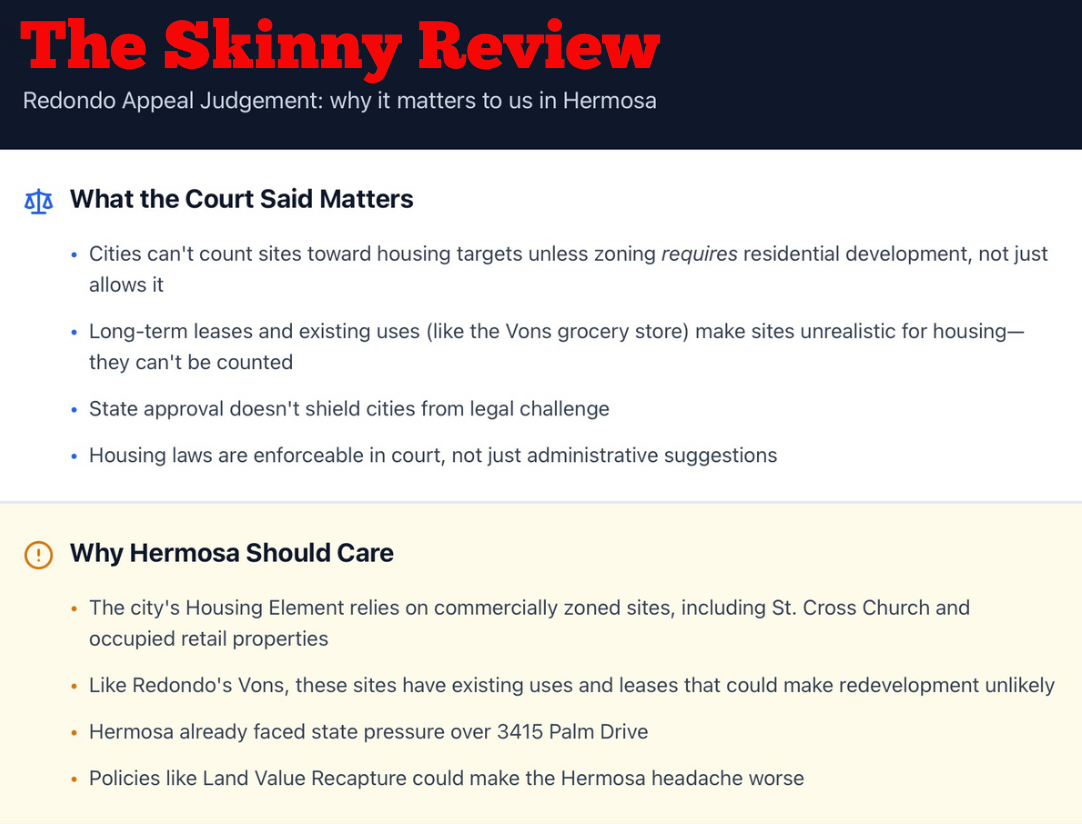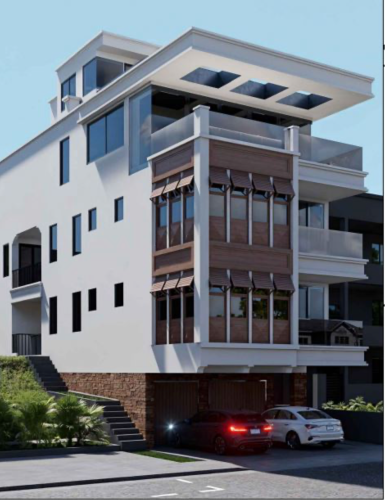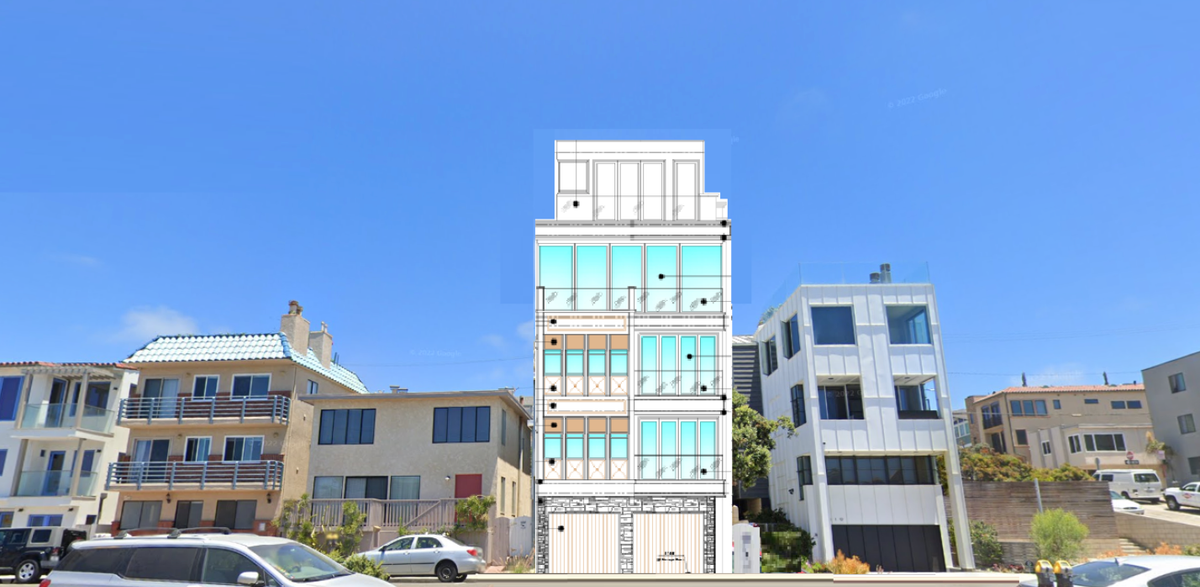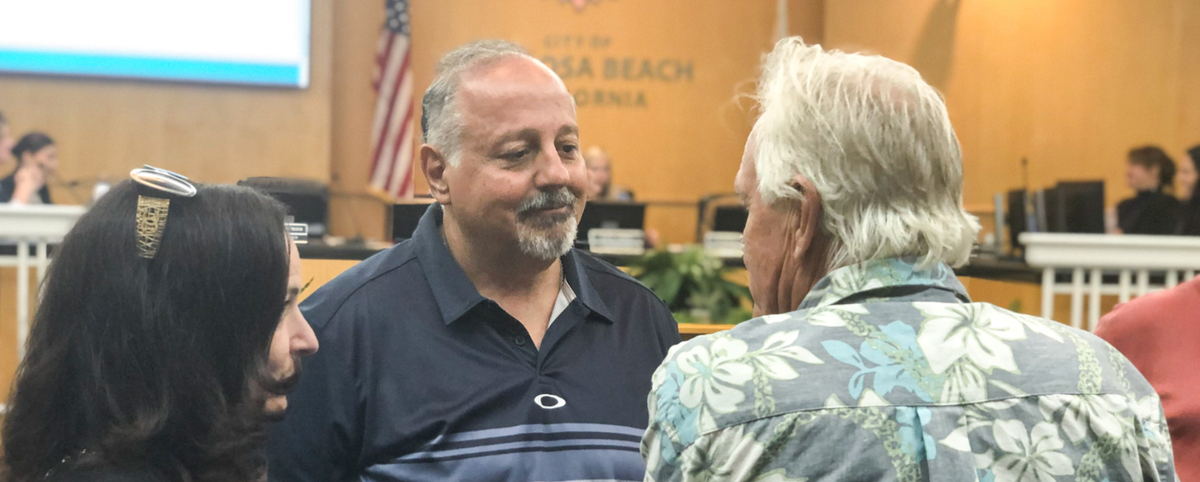Redondo loses appeal in Housing Element lawsuit
Redondo Housing Ruling Casts Shadow Over Hermosa's Development Battles

Redondo Housing Ruling Casts Shadow Over Hermosa's Development Battles
A state appellate court just handed Redondo Beach a stinging rebuke over its housing plan and the reverberations might be felt here in Hermosa, where fights over a local apartment development and a controversial land tax proposal have already put housing policy in the spotlight.

The Court of Appeal ruled yesterday that Redondo's Housing Element violated state law by banking on "residential overlay zones" that allowed housing on commercial land but didn't actually require it. The court's message: hoping developers might build housing isn't the same as planning for it.
Leo Pustilnikov - Hero or Villain ?
The case involves controversial developer Leo Pustilnikov, who is the lead owner of the AES power plant site in Redondo. He currently has a number of pending legal cases against the city, with this appeal verdict now front and center.

Pustilnikov is also involved in legal battles with the City of Beverly Hills over projects where he is claiming rights granted under state law and the 'Builders Remedy' provision. This allows developers to override local zoning laws (including height limits) when cities fail to have their plans for housing development certified as compliant by the state.
"At the end of the day, I like real estate and residential real estate because everyone needs to be housed. I’m a firm believer that housing is as close to the universal right as we have, and that people shouldn’t be left to suffer on the streets." (Leo Pustilnikov, speaking to the Beverly Hills Courier last month)
Under state law, cities must identify sites where housing can realistically get built, especially affordable units. That means zoning that mandates residential use at a minimum of 20 units per acre—not zoning that makes it optional.
"The message from the court is clear—planning for housing on paper is not enough," said a Los Angeles land use attorney familiar with the case. "Cities must use zoning that results in real housing opportunities, not theoretical ones."
What It Means Here
Hermosa Beach is dealing with its own version of this pressure cooker. The recent storm over 3415 Palm Drive (where a proposed apartment complex planned to use the Builders Remedy provision to exceed the city's height limits) showed what can happen when local beach neighborhoods meet Sacramento housing policy.

When the neighbors on Palm Drive complained that a proposed 53' high development would affect views and neighborhood character, the Developers pointed to state law. The city found itself caught in the middle, knowing it couldn't reject projects that checked the legal boxes. The project came about because of Hermosa's failure to submit a compliant Housing Element plan to the state back in 2023. A compromise was recently reached with the private developers to resubmit plans for a 35' high development, but there are now fears that given this latest Redondo judgement, Hermosa may not be so lucky next time.
Now, with Redondo's overlay plan struck down, Hermosa could face even closer examination if its zoning strategy looks similarly vague. "Hermosa is watching closely—no city wants to be caught in non-compliance," said one resident who lives near the Palm Drive site.
IN DEPTH : Read more about the Palm Drive controversy here
The Land Value Question
Then there's the Land Value Recapture policy pushed by the previous City Council—a plan to claw back some of the windfall developers enjoy when the city upzones their property. Supporters like former councilmember Justin Massey argued it would ensure the public benefits when private land values spike. Opponents worried it would scare off builders and gum up the approval process. Evidence so far suggests that it is acting more as a deterrent to new housing than as an incentive.
Post-Redondo, housing watchers say cities need to tread carefully around policies that could make projects pencil out to failure. "Policies like Land Value Recapture will be carefully examined," said another local land use expert. "If they create barriers to realistic housing development, they could face legal challenges under the same logic used in this case."
When does a supermarket equal a church ?
One of the sharpest parts of the Redondo decision involved sites that aren't actually available. The court tossed out a property leased to Vons, ruling that a long-term grocery contract effectively blocks redevelopment—meaning the site can't count toward housing goals.
Hermosa has its own version of this problem. The city's Housing Element includes the St. Cross Church site and several other commercially zoned properties to meet state-mandated housing targets. But like the Vons in Redondo, these aren't empty lots waiting for shovels. The church property is occupied and actively used. Many of the commercial sites carry existing leases or operating businesses that show no signs of going anywhere.
If Redondo couldn't count a grocery store locked into a lease, it's unclear how Hermosa can count a functioning church or strip mall tenants with years left on their contracts. The legal standard is the same: sites must be realistically available for housing, not just theoretically convertible on a zoning map.
That puts Hermosa in a bind. The city needs to demonstrate it has enough properly zoned land to meet its Regional Housing Needs Allocation. But if occupied sites can't count, the inventory shrinks fast in a city where nearly every parcel is already spoken for.
The State Is Telling Not Asking
Even though the state's Department of Housing and Community Development signed off on Redondo's plan, the court made clear that HCD approval doesn't insulate cities from legal challenge. Compliance is a matter of law, not bureaucratic blessing.
As Hermosa works through its own housing commitments, including rezoning deadlines tied to its share of regional housing targets, the ruling underscores a shift: housing mandates now have teeth.
"This decision signals that housing laws are no longer procedural—they are enforcible," the attorney said.
For Hermosa, the question may no longer be whether to grow, but how much control it has over the terms.

RELATED CONTENT :









